News
COVID-19 RESPONSE: Office Building Closed
March 19, 2020Update to our Clients and Business Associates
In accordance with the Pennsylvania Governor’s order, RLPS has temporarily closed our office building. All RLPS Architects and Interiors employees will work remotely until state and national officials indicate it is appropriate to resume physical business operations.
In the interim, we will continue to provide services as follows:
- Meetings will be accommodated via web conferencing technology or rescheduled as needed.
- Email and telephone communications with project team members will continue uninterrupted.
- Calls to our main office number, 717-560-9501, will be answered by an automated attendant with a dial-by-name directory to access individual extensions. Those calls will be forwarded to the employee’s cell phone or to voicemail which will send an alert prompt.
The RLPS team remains committed to doing everything we can to keep our clients’ projects moving forward and ultimately minimize the long-term impact of this pandemic for all of us. Please contact us with any concerns or if we can assist you further at this time.
Sincerely,
Michael J. Martin, AIA / Managing Partner
Architecture Professors Have No Hearts (Even on Valentine’s Day)
February 11, 2020Life as a college student in the late twentieth century could leave you a little disconnected from society. See, most people didn’t have cell phones, the internet was essentially in its infancy, and heck, we didn’t even have cable TV most of the time I was in college. Maybe someone could pick up the local radio station, but mostly people’s boom boxes blasted competing musical genres from CD’s. Life as an architecture student was even more isolated. I would go days without seeing my roommates, as we spent most of our time in studio. We actually drew on paper and had to do that outside of our 8 foot by 8 foot dorm rooms.
Our kind (architecture students) would miss entire world events sequestered away at our drafting tables. I remember, or rather fail to remember, the following events:
The October 1993 deaths of 18 US soldiers in Somalia
The February 1993 bombing of the World Trade Center
The November 1994 death of Tupac
The April 1995 Bombing of the Federal Building in Oklahoma City
You’d think there was no good news in the early 90’s. But it seems that nearly all of these times corresponded with a massive design critique in architecture school. World events were of secondary concern.
The same was true of holidays. In 1996, I should have had my first Valentine’s Day with the woman who is now my wife. Nay Nay. Turns out, our professors decided that we should spend the holiday with them working on our thesis for the last major critique prior to completion. Lucky for me, my girlfriend was in architecture too. Convenient, right? So we decided to celebrate the day after Valentine’s Day.
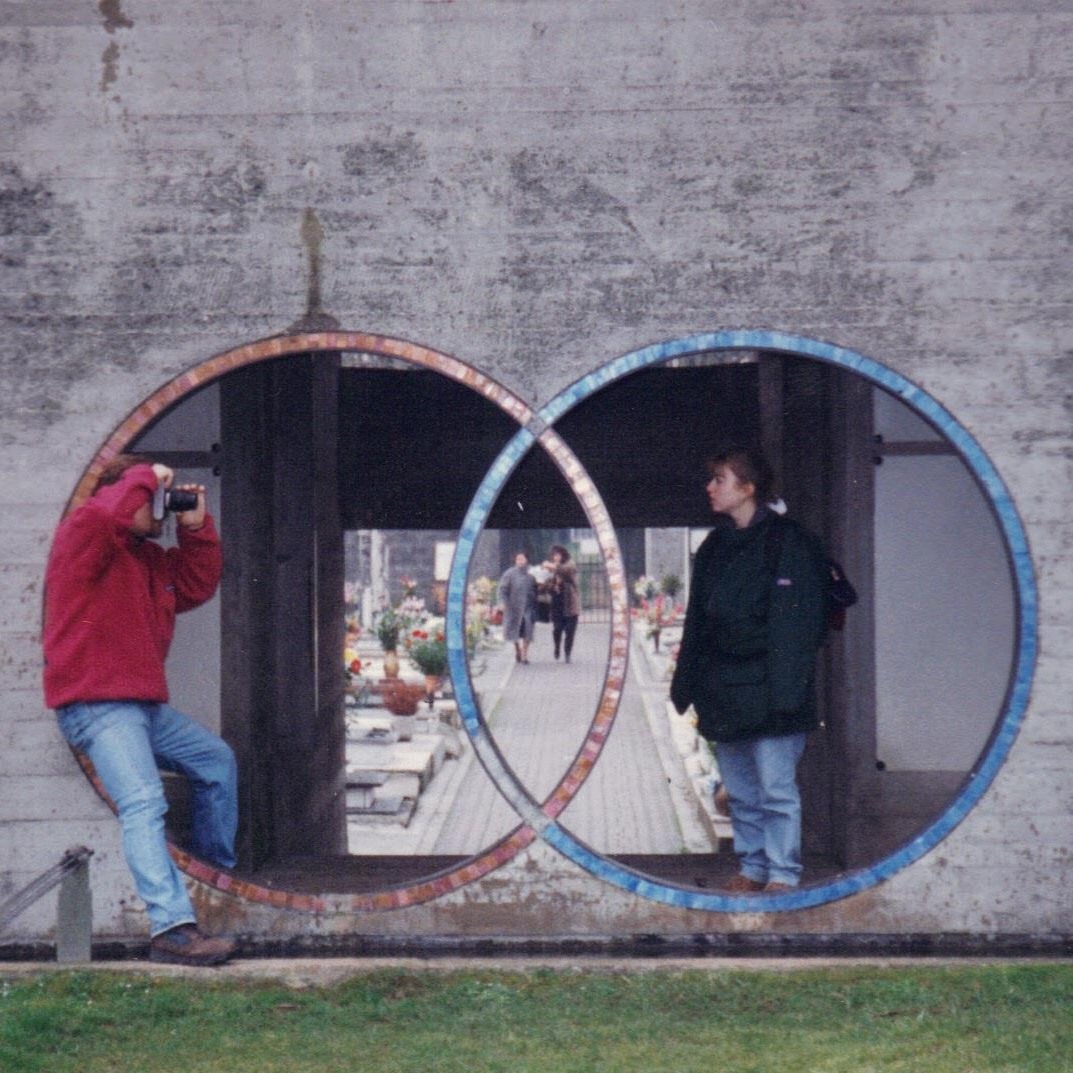
In somewhat related circumstances, after 10 semesters worth of tuition, we decided to limit our gifts to each other to ten dollars. After some well-deserved sleep, and an overdue shower and shave, I went over to my girlfriend’s apartment. Most everyone else who celebrated the holiday had already done so by this time, but I had a small bundle of goodies to share with my honey. When I say bundle, I mean a plastic bag from the convenience store I stopped at on the way over. Romantic, huh? Go ahead, you jump to your conclusion and see how you feel in the next paragraph…
When we met up, we each held our “gifts” behind our backs. On the count of three, we exchanged them like hostages. I reached into the bag I received and found nearly identical chocolate treats to those I had purchased. We looked at each other, laughed, and realized that we both bought candy the day after Valentine’s Day at a heavily discounted price! That makes the chocolate even sweeter to me, and I might add that my wife regularly looks for day-after-the-holiday goodies to this day. Continuing on to the card, we each had added a scratch off lottery ticket to the other’s envelope.
In the end, love overcomes all, including mean old architecture professors. Consequently, my wife and I continue to limit our Valentine’s Day spending to $20 (we adjusted for inflation).
Wash Those Dirty Hands!
November 11, 2019I was lucky enough to attend the Twenty-Third Annual Westford Symposium on Building Science – also known as Summer Camp. It was a truly informative experience and, as the title suggests, it touched on many subjects relating to building science. Plus there is a really great barbecue and picnic at the organizer’s home. But is wasn’t all about R-values and air leakage, though. While the symposium covered many topics I expected; like humidity, air-tightness and unvented roofs, it also touched on several other topics that were unexpected (to me anyway).
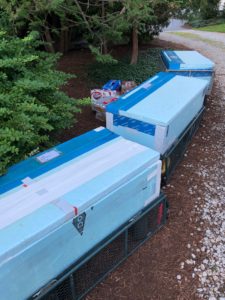
The one session that maybe struck me with that “duh, why didn’t I think of that” moment, was called, “Architectural Compactness and Hot Water Systems: Good Design Lowers Cost”. Now, I know what you’re thinking – with a title like this, how could you go wrong? But here’s the thing: I’ve thought about this session every time I touch a sink faucet since.
Whether in public buildings, apartments or houses: the faucet is usually really far away from the hot water source. Your second floor bathroom can be on the far side of the house and the hot water heater is located in the garage or mechanical closet, or even the basement. Even if the hot water source happens to be on the same floor as the faucet, the pipes have to run up in to the floor or ceiling, then run horizontally to the wet wall, then up or down again, before it sees daylight. Prior to any hot water reaching your hands, that pipe has to clear a huge volume of cold water that is already in the trunk and branches.
In the study done by the presenter, it found that 80 to 90 percent of the water draws in a typical residence were from the faucet, so let’s concentrate on that for a moment. In the 1980’s the typical faucet in a home used 3.5 gpm (gallons per minute). Today, the worst you can do by code is 2.2 gpm and most efficient faucets are closer to 1.2 gpm. So even though faucet efficiency has improved drastically since the 1980’s (about 66%), we are still wasting a lot of energy down the drain. We are just waiting for it to get hot!
Everybody washes their hands, right? Well, they should, anyway. The CDC (Center for Disease Control) says you have to wash your hands with soap and water for at least 20 seconds. For the record, the CDC recommends singing the “Happy Birthday” song from beginning to end twice. I wish I had known that earlier, because anyone with kids has probably heard their kids turn on the water long enough to only get through “Happy Birthday to y….” & done. But I digress…
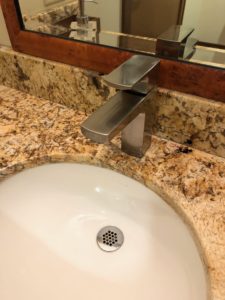
While much of the session was focused on how to keep the “wet” rooms closer to the source. Clearly, we designers can and should learn to do better. But the clearest takeaway for me was this: we wash our hands a lot. Our faucets are usually a single lever, as they are accessible, convenient and easier to change the temperature. If our levers are positions in the “neutral” position (half hot, half cold), and we turn it on 60-100 times a day and run it to wash our hands, we are wasting a lot of hot water!
If we run our faucet for the recommended 20 seconds (minimum, I hope), there is almost no way in most houses (or offices or public restrooms for that matter) that the water will be hot by the time we are done washing our hands. The water already in the pipe is unheated. I know in my house it can take a minute or more for hot water to reach my second story bathroom faucet. An eternity.
But if my faucet is drawing hot water as well as cold when washing my hands, I’ve wasted a lot of energy to heat water that will never touch my hands. By the time the next person touches that faucet, the water I heated in the pipe line will have cooled off because the copper in most houses is not insulated. By simply turning the faucet lever all the way to the right, I use only cold water to wash my hands. No energy wasted.
I came home from Summer Camp all excited about this revelation. There is an obstacle. People (the people I know, anyway) don’t like it when the faucet lever isn’t lined up and nice and straight. My wife, for one, was not impressed. There is a compromise now! In addition to the water efficient faucet, I am told that faucets that will only draw cold water when the lever is straight up and down unless you push it to the left while the water is on are on their way to the market. That way you can leave the lever nice and straight, and not waste that energy.
By the way, the CDC doesn’t care if the water is hot or cold, so unless you have a medical condition, why not use cold?
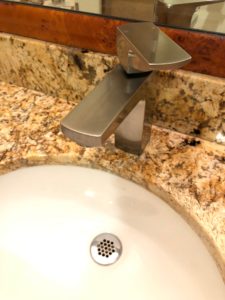
Accessible Doesn’t Mean Institutional
September 3, 2019Many designers and consumers alike have an aversion to anything labeled: accessible. That particular label on an apartment can have a connotation of “institutional” or just plain not looking like all the other residential units. Even in retirement living, the Type A apartments (or so-called “ADA” units), which are required by most building codes to comprise of at least 2% of the total apartment units in a development, are often the hardest to sell. Why? Because they (can) look different. However, with a little creativity and just a couple extra design features, these adaptable units can be almost indistinguishable from the other 98% of the apartments.

To back up a little (warning: building code lesson), all apartments in multi-family living have to meet certain usability requirements. This is a result of the Fair Housing Amendments Act of 1988, which augmented the original Act of 1968 to extend housing opportunities to those with disabilities. It’s worth noting that this amendment to the Act preceded the Americans with Disabilities Act by two years. The 1988 Fair Housing Act covered all new construction housing after 1991 that connects more than three dwelling units together to meet minimum accessibility requirements. That means that single family homes are exempt, but townhomes, apartments or any other dwellings of four or more connected by any means are regulated, whether rental, simple ownership or condominium. Developers and owners are sometimes unaware of these minimum standards despite the three decades since the law’s implementation.
This means that even the “standard” units in a typical apartment building, typically called Type B, have to meet some minimum standards. These standards include reasonable accommodations to residents even if that may require the resident to modify the unit (at their own cost, mind you, not the landlord’s). The Type A adaptable units, the 2% mentioned above, are scoped out by most building codes. These standards exceed those required even by the Fair Housing Act above, but not to fully accessible criteria as required in, say, a public bathroom.
The main differences between the two types of units lay in the bathrooms and the kitchen. There are other differences, but they probably will not be recognized by the average consumer. Doorways have to be a quarter inch wider, doors need to have certain clearances in front of them and some receptacles and electrical outlets may need to be lower or higher, but only slightly so.
The area dedicated to the bathrooms of the Type A adaptable unit may be larger than the other units, to allow for the five foot turning radius that a wheel chair requires and some of the clear space requirements on the individual fixtures is larger than those required at Type B units. Other than these differences, however, the actual appearance of the adaptable bathroom can be identical to the standard Type B units. The regulations require that in-wall blocking be installed in the bathrooms at the showers and the toilets for the future installation of grab bars and a shower seat. These items do not have to be installed, however, and the blocking is invisible in the finished product. The sink does need to allow a wheel chair to clear the underside, which in many cases eliminates a base cabinet at this location. Even here, the code allows for a removable cabinet, provided it may be removed easily and the flooring and wall finishes continue behind it. A conscientious designer can incorporate a removable sink cabinet that appears to be built in, matching the appearance of any other bathroom in the building. Shower control locations in adaptable units are also required to be on the long wall of the 3’ x 5’ showers typically provided in senior housing. This can place the shower wand in a location that would spray water out of the shower, as opposed to if it were located on one of the short walls. But the code does not prohibit a diverter and a second, fixed head on the short wall, nor does it prohibit a slightly longer hose on the wand and a second holder on the short wall. Either of these solutions, paired with a wand that has an “off” switch on the dial, can overcome this obstacle.

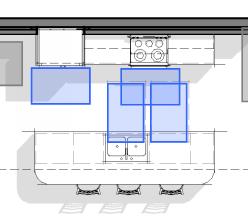
The clear areas dedicated to the kitchen probably is exactly the same between the two types of units, so the Type A kitchen will not necessarily larger than its Type B counterpart. There are, however, two main differences to overcome. First is the provision for a wheel-under sink and a wheel-under work area in the cabinetry. These open cabinets can be filled in exactly as described in the bathroom above. These removable bases can be indistinguishable from those on either side, and removed with just a couple of ordinary screws. The second issue is a little harder to hide. The sink and the work surface have to be a 34” above the floor, which is 2 inches lower than a standard kitchen counter. Typically, the entire kitchen counter is lowered to maintain a consistent countertop height, and while this isn’t required, it does eliminate two low spots on an otherwise regular surface. This is one concession to accessibility that may be difficult to circumnavigate, though in our work in senior living with reputable providers, we have procured variances from the agencies administering the codes to allow traditional 36” countertops provided the building owner promises to replace the entire kitchen counter and necessary cabinets upon the request of a resident. If a variance can be obtained, this essentially eliminates any difference between a Type A and a Type B kitchen.
Designing for accessibility is nothing new, however. Nor should it negatively impact the design. Inform the design – yes: ruin – NO! A real groundswell in advocacy began, with good reason, after World War II. Many thousands of service personnel returned to the US dealing with the physical and mental consequences of modernized warfare. The housing and public facilities to which they returned were not accommodating, and in 1946 a group of paralyzed veterans founded The United Spinal Association in New York; the Paralyzed Veterans of America was founded in 1947; the National Paraplegia Foundation in 1948. Just a few years earlier, accessibility issues were never talked about, not even by our wartime president FDR, who himself used a wheelchair for much of his adult life as a result of contracting polio. But thanks to these service men and women, accessibility advocacy was about to shift to the forefront of public conversation.

Even many architects don’t know that Frank Lloyd Wright, America’s preeminent designer of the first half of the Twentieth Century, designed a house specifically for a client with a physical disability in Rockford, Illinois. In 1949, Wright designed a home for Kenneth Laurent, a disabled veteran, and his wife. The Laurents obtained a $10,000 (that’s about $140,000 today) federal grant for disabled veterans, and Mrs. Laurent wrote to Wright after seeing the Pope-Leighey House in the magazine House Beautiful. She asked Wright if a house could be designed for a wheelchair user on a $20,000 budget. Most of Wright’s Usonian homes are single story and open floor plan affairs. Both of these attributes compliment universal design well.
The Laurent House is consistent with the Wright look and feel, and the incorporated accessible details do not call themselves out. The custom desks, which cantilever from the walls and are completely open below, are as at home here as they would be at Fallingwater, Wright’s famous Pennsylvania home cantilevered off the side of a hill over a waterfall. Even the various storage cabinets fronts were designed to hinge on the bottom instead of the side, making it easier for the client to open them from his wheelchair. The living areas do not express any hint of institutional design. The only perceivable trace at the time may have been wider doors, which to today’s eyes, look completely normal, but in the 40’s it was customary to have 30” bedroom doors rather than a much more wheelchair friendly 36”. Obviously, there are no steps to create barriers into the house from any of the exterior patios, terraces or the carport. Wright’s typical wide overhangs would protect those thresholds from water as well as snow accumulation.


The bathrooms and kitchen were probably the biggest challenge to Wright, as they are to designers today. But it is remarkable that his solutions 70 years ago are strikingly similar to solutions still used today. Let’s be honest. Men of the 1950’s did not likely spend a lot of time in the kitchen. But Wright lowered the countertop to a height similar to the standard required today. To do so, he used a drop in style range so it could be flush with a lower countertop and the controls are all on the front, so that one does not need to reach across the burners and hot pots and pans to adjust the heat. That is an explicit requirement of Type A kitchens today. The kitchen is an open floor plan and allows generous maneuverability within the space. While the kitchen sink is not open below, it is positioned to allow side approach to it. All in all, even with the lower counters, the kitchen looks very much like many other FLW kitchens, and I have visited several.

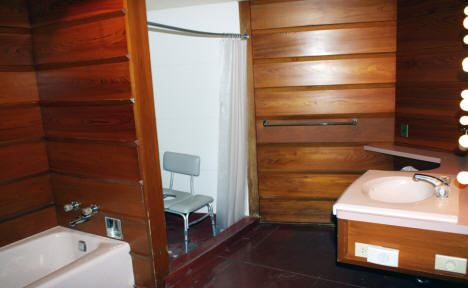
Wright would have struggled a little with contemporary codes in the bathroom, but nonetheless he came up with a few innovations here worth mentioning. In addition to the traditional bathing tub, Wright added a shower next to it. While it is not a true roll-in shower used today, it has a much shallower curb and would allow for easier transfer to a shower chair than anything readily available in the 1940’s. And while there is not as much clearance at the toilet as you would see today, the lavatory cantilevers from the wall and allows full wheelchair clearance below, which was rather innovative for its time.
The fact that the Laurnets lived in this house for 60 years is a testament to Wright’s foresight into what would one day be called universal design and allowing the family to age in place in their home. They even added on to the house when they adopted a child years later. Perhaps Wright’s age when he first conceived of the home aided his design. He was 82 years old and probably less mobile than he was in his youth.
Accessibility features in living units do not have to constrain design or stand out like billboards. Done sensitively, these features can work seamlessly with the overall design of the space, making it usable to the widest range of potential users possible. It will not just eliminate barriers for those with disabilities, but it should benefit as many users as possible, from those in wheelchairs to those on skateboards.

Congratulations Kelly Wood!
August 20, 2019RLPS Interiors is excited to announce that Kelly recently passed the National Council for Interior Design Qualification (NCIDQ) Examination and earned her NCIDQ Certificate. The rigorous, three-part examination covers all aspects of the interior design professional practice and related topics such as codes, sustainability and universal design.
An RLPSer since May 2013, Kelly earned a Bachelor of Arts, Art History from Wake Forest University and a Masters of Science, Interior Architecture & Design from Drexel University. In celebration of this accomplishment, we asked her to share a few thoughts about her journey to earning this accreditation.
What was your inspiration to become a commercial interior designer?
My parents were the inspiration that led me to where I am today. We didn’t have a lot of material things when I was growing up, so anything we needed or wanted, my parents provided by using their hands and creativity. My dad could build anything. My mom could sew anything. They are an incredible team—hard working, practical, kind, and loving. I thank God every day that I’m their child!
In addition to that foundation, I like being purposeful in everything that I do so interior design seemed to be the perfect balance for me. I was happy to find a profession that encourages creativity, has practical applications, and serves others.
What was your motivation for obtaining this credential?
Becoming certified was something I wanted to prove to myself that I could do—that all my time spent in college and then working within the profession had prepared me for the ultimate test. I have always set goals and pushed myself in other aspects of my life, so pursuing this career goal was a natural step for me. I knew it wouldn’t be easy, but I also knew it would strengthen me professionally, regardless of the outcome.
What were your study habits when preparing for the exam?
The entire study process was somewhat comical because I decided to start a family AND my journey to NCIDQ certification at the same time. When I was pregnant with my firstborn, I was able to carve out time to study any day of the week. I did not realize how rare that would become. After baby one, two, and three in consecutive years, my study time became extremely limited – especially when my husband was working. He’d be gone 24 hours at a time, 15 days a month so I had to be disciplined and take advantage of study time whenever possible.
Eventually I fell into a rhythm that worked for our challenging schedules. As soon as the last baby was down for the night, I’d whip out my books and materials and study until I couldn’t keep my eyes open anymore. I accepted the fact that as painful as it could be on some nights, it was temporary. Luckily, I wasn’t used to sleeping through the night anyway!
Having kids to take care of at all hours of the day and night set me up for success in the long run. One of the nicest parts about the journey was having them along for the ride. Each of them was in my belly at one point so whether they liked it or not – they were part of the process. Every time I took an exam, I could feel one of them kicking inside me. It was my very own little reminder that no matter how nervous I was on exam day, I wasn’t alone.
My husband Ty was a great help as well. When he was able to be home, it was awesome to steal away some time to study. His love and encouragement never wavered and there’s no way I could have done it without him. I’m just so happy it’s behind me!
What are you looking forward to doing now that you have a bit more free time?
I’m not quite sure I will have a lot of free time in the next 18 years, but I look forward to sleep whenever I can get it.
Wondering about the photos?
It’s an RLPS tradition that firm partners cut the scarf (or tie) of a newly credentialed interior designer or architect during our monthly staff meeting. Although the history of this practice is a little murky, the tradition continues mostly because it’s fun and certainly worth celebrating the achievements of our staff members.

Join Our Team – Construction Administrator
August 5, 2019
Current Position Opening
RLPS is seeking a Registered or Graduate Architect/Architectural Engineer with a minimum of five years’ experience. Candidates must have knowledge of construction contract documents and building code requirements. You will be the point person during the construction phase with diverse responsibilities for providing document reviews, responding to information requests, coordinating job site meetings and visiting construction sites to visually assess progress and quality of work. This position includes travel and requires strong organizational and communication skills working closely with other team members and personnel on job sites.
Founded in 1954, RLPS is a full-service architectural and interior design firm in Lancaster, Pennsylvania. Our promise is to share our passion for what we do – for projects large and small throughout the country, serving our clients in the senior living, educational and commercial markets, or for “after-hours” creative pursuits like our annual gingerbread display. RLPS offers a competitive salary and benefits package, continuing education opportunities, and many extras from bi-monthly catered employee lunches to our summer hours option.
To confidentially apply for this full-time position, please send your cover letter and resume to Stacy Hollinger Main, Partner, at humanres@rlps.com or 250 Valleybrook Drive, Lancaster, PA 17601. Equal-opportunity employer
This Old Architect
July 21, 2019Surprisingly, many of the lessons I’ve learned over the years have little to nothing to do with designing buildings. That doesn’t mean they weren’t worth learning.
Recently, my wife and I were fortunate enough to visit the set of This Old House, which is to say, the active work site of a home renovation in Westerly, Rhode Island. I won a contest as a member of what they call the “Insiders”. It’s a yearly subscription where you get access to every show produced, plus a digital version of the magazine, plus New Yankee Workshop. This is not a commercial but seriously, if you are fan, check it out.
I was extraordinarily excited to put it mildly. My daughter heard me talking about the upcoming trip and hit me with the “Nerd” label. Whatever…! I was stoked. I watched the show as far back as I can remember. You watched what was on then and there were only 12 channels to choose from back in those days, but as my studies and career led toward architecture, I continued to watch. Even with the flood of home improvement shows of the last couple of decades that concentrate on the entertainment rather than the education aspect; or the shock value rather than the shop value, This Old House was always my go to program.

My wife and I watch every Saturday morning with our coffee, whenever possible. We watched together before we even owned a home. In fact, she will be the first to tell you that it was because we would watch this program together and then launch right into a Penn State football game on a Saturday morning, that it first occurred to me to ask her to marry me. Well…It didn’t hurt.
The trip from Southeast PA to Rhode Island was not going to be an easy one, we knew. It is about 300 miles but can take anywhere between 5 and 6 1/2 hours, depending on traffic in the greater New York area. We had to brave it in a torrential down pour, too. We left the night before the shoot in order to be on site by 11 AM on a weekday. We got to our hotel at about 11 PM. The following morning, our hotel room electronic lock decided to malfunction while we went to breakfast. I think I may have scared the young lady working the desk at our hotel after her efforts to open the door went nowhere after about 40 minutes. I believe I demanded a locksmith, another room to shower in, and threatened to tear to the door off the hinges in order to get to the show.
Eventually, the door opened, but we were warned not to shut the door unless someone was inside to reopen it. We only had a short 15 minute drive to the job site. We even had a couple of minutes to spare and drove around the neighborhood and to the shoreline, which was only a mile or so away. Unfortunately, the rain the night before had flooded the shoreline streets, so we had to turn back.

The project house sat at the back of a cul-de-sac bristling with activity. We parked a little way away to keep out of the hustle and bustle of the various work trucks. Other cars started showing up and looking for a place to park like we did. After a while, everyone started migrating over to a pop up tent that looked to be our welcome center. A young man with a huge smile stood at the entrance into the cul-de-sac to greet us – his name was De’Shaun Burnett and we came to learn he was one of the newest apprentices along with Kathryn Fulton. They were so engaging and happy to see all of us, that by the time we had to leave the site, I wanted to adopt them!
As the other winners of the contest assembled, we found that there were about 15 winners and 15 guests coming. Most of the visitors were husband and wife and most of the winners looked to be retirees. So my wife and I pulled the age demographic down – I think there were 3 couples in our age range (40’s) and one couple in their 20’s, but the rest seemed to be in their 60’s. Then I saw the host, Kevin O’Connor walking around the site! I resisted the urge to point and shout, but his presence was definitely noticed by all the other visitors too.

It was an active job site indeed. My wife was in the residential home building industry for a decade, and she commented that she missed the smell of fresh sawn lumber – there was definitely real work being done. At the appropriate time, all of the guests were ushered into a second floor bedroom to watch a very small monitor of the opening shot for the day. There were about 30 folding chairs facing a screen about 24 inches wide. It was kind of funny and Chris Wolfe, who is the Executive Producer and General Manager of all the This Old House Productions television series, made light of the fact that they pulled out all the stops for our visit. It was Chris’ job to entertain us all until the production team was ready downstairs. The group was very engaged and asked a lot of questions, and Chris was reprimanded on one occasion for making us laugh too loud. Questions mainly pertained to the process of how they pick the project houses, at what stage is the design in when they do, how long the process is, etc. The Q&A session could be a long post in and of itself.

The house was essentially fully framed but drywall had not yet started, so from where we sat, we could see the entire floor through the open studs. Obviously any noise would travel down the open stairs to where the team was shooting. They started with the “long open” shot, where Kevin O’Connor arrives on site and walks through the house and happens upon whatever work is happening that day. This day happened to be installing a coffered ceiling detail. We learned later that it was supposed to be installing some doors, but the rainy weather required the team to reorganize the day at the last minute. We obviously had to hush during camera rolling, then between takes, Chris would described various facets of production. During the long shot shooting, we learned that there really is no script, just an outline. Kevin will assess the progress on the house since the last day of shooting and talk with the show runner and crew about what he might say. I think the long shot took about 3 takes and each time Kevin would edit himself and make the shot smoother.
Once he got to the work area inside the house at the end of the long shot, Tommy and Jeff were positioned to talk about the mock-up of the wood trim detail that would become the coffer on the ceiling. It too started with an initial conversation with the show runner about what the viewer would be looking at and what was important to talk about. This shot was more technical and took quite a while to shoot, each take was a more condensed and streamlined version getting to the essence of what needed to be conveyed. It was very interesting. After the initial shot at the work table, various B roll shots were taken for close ups of the work. Care had to be taken to make sure there was continuity with the overall shots previously taken. Questions were posed by the show runner, like “weren’t you holding that with your other hand in the other shot?” As a viewer, you don’t often think about these issues – if the show is done well (obviously, This Old House is).


Once they left the work table shot, they prepared to shoot in the living room where the coffers were to be laid out, so the group was allowed to go downstairs and watch the shot in person. Tommy and Jeff used a layout stick to mark the floor of the room and those marks would later be transferred to the ceiling using a laser. This part was really cool because we could see not only the “shot” but all that goes into the shot. You can see show runner John Tomlin talk to the hosts and ask them to redo a part of the scene, or the camera operator crouched on his knees or how the “extras” walk through the shot the same way every take. Up until this point, the only regular cast members we had the chance to see were Kevin, Tommy and Jeff – and that was all we were expecting to see. But during the end of the shooting for the morning, I turned my head and was surprised to find I was standing right next to Richard! He saw me do a double take and smiled, and after I pointed at my camera and then at him, he nodded with a sly grin.
After shooting, Richard took us outside to talk about how special the septic system here was. As exciting as that subject seems, I really don’t remember what he said about it, but he actually became my favorite story teller of the cast. He genuinely seemed like he wanted to talk to 30 strange fans and even answer one guy’s oddly specific and detailed sewer questions. He talked about how his sons came to decide to work with him in the business, how he took over for his own father in the speaking roll on season one of This Old House 40 years ago after his father got tongue tied and passed those duties on to him in his early 20’s, and finally about how Tommy pranked Kevin the very first time they met by nailing his tool box down to the ground. I left there thinking about applying for a job at his shop! While we were outside, I caught a glimpse of Mark, the masonry expert.

After we talked about sewage for a good long time, we were ready for the barbecue that was part of the contest winnings. They set up tables on the deck and through the house, luckily the weather changed and it was sunny and delightful outside. There was a big buffet of really tasty food. While in line we chatted with a really nice couple who was very close to our age and got tips on where to go on our planned vacation to Rhode Island a month later. we got the skinny on which Newport mansions to see, where the best beaches were – what luck!
We ended up sitting down to eat at a table with Jeff Sweenor, the builder they recently collaborated on with the Net Zero house season, and were working with him again. Chit chat included a discussion of the special wood trim being used, called Solid Select. It is an exterior grade trim that comes from New Zealand that is treated for outdoor use and comes pre-primed. It is so straight and defect free, they not only used it for exterior trim, but used it throughout the interiors as well. Sadly, no one carries it outside New England – yet.
After we finished eating and wiped all the barbecue sauce off our hands, I got all the cast that was there (pretty much everyone but Norm and Roger) to sign my copy of the recent This Old House book. I don’t care if that makes me look like a dorky fan-boy, when else would I get a chance like that? After that, the crew in charge of the Insider contest winners coordinated a lot of photo opportunities which made their way into a very nice article on the day here: TOH Westerly

Jim Mehaffey, AIA, Senior Project Manager
I am an architect with 20-plus years experience in the health care and senior living sector. I am an enthusiastic pragmatist and fan of sarcasm.

SPRING / SUMMER CONFERENCES 2019
July 20, 2019Spring is a busy time for conferences at RLPS. It’s a great opportunity for sharing ideas, learning new things and connecting with our clients and business associates. Please let us know if you will be attending any of the upcoming conferences so that we can say hello.
WE HOPE TO SEE YOU SOON!
LeadingAge Florida Convention and Exposition– July 22 – 23; Orlando Florida – Booth 301
PA Educational Leadership Summit sponsored by the Pennsylvania Association of School Administrators and the Pennsylvania Principals Association – August 4 – 6; Kalahari Resorts Pocono – Booth
THANKS TO ALL WHO ATTENDED!
Pennsylvania Association of School Board Officials (PASBO) – Booth 116
KAPPA/DVAPPA Spring Meeting – Summer Breeze, Successful Campus Housing Updates presented by Mike Wetzel, Franklin & Marshall College, Brett Calabretta, Warfel Construction and Carson Parr / Booth
LeadingAge Leadership Summit – Experience Design for Senior Living presented by Buck Sleeper, EPAM Continuum and Gregg Scott / Kiosk
National School Board Association (NSBA) – Media Center Design Challenge: Hands-on Student Experience Utilizing the 4 C’s
LeadingAge Illinois – The Wave of the Future: Urban Senior Housing Opportunities by Jeff Heitgerd, CliftonLarsonAllen, Eric McRoberts and Dustin Julius and Make Your Markque: Holistic Branding Strateiges for Senior Living Communities by Andrea Guarino and John Mulder, 3Seed Marketing and Jessie Santini / Booth
Environments for Aging (EFA) – April 7 – 10; Salt Lake City, Utah / Get Smart: Smart Home Design Strategies to Improve Quality of Life & Support Aging in Place by Patrick Sampsell, Masonic Villages and Dan Godfrey; Make Your Marque: Holistic Branding Strategies for Senior Living Communities by Rob Love, Love & Company and Jessie Santini; Community Conversation: Designing for People Living with Dementia by Michael Smith, Livewell Alliance, Inc. and Dustin Julius and Better Baths and Creative Kitchen Designs by Eric McRoberts and Jessica Jack.
LeadingAge Maine and New Hampshire Conference & Expo – April 10 – 11; Portsmouth, NH – Innovation Exchange – Hybrid Homes – Evolution in Independent Living by Bill James, RiverMead, Eric Endres and Rob Beal
LeadingAge North Carolina Annual Conference – May 6 – 9; Myrtle Beach, SC – Housing 2020: Innovative Design and Financial Models for Independent Living by Mario McKenzie, CliftonLarsonAllen, Craig Kimmel and Brent Stebbins
United Methodist Association (UMA) Annual Meeting – May 8 – 8; Ft. Myers, FL – Fostering an Employee-Centered Workplace by Steve Jeffrey, Garden Spot Communities and Jessie Santini
LeadingAge Virginia – June 5 – 7; Norfolk, VA – Make Your Marque: Holistic Branding Strategies for Senior Living Communities by Jessica Kraft, Bluespire Senior Marketing and Craig Kimmel
Association of Independent Colleges and Universities of Pennsylvania (AICUP) Meeting on Collaboration – June 19 – 20, Harrisburg, PA – A Second Life for a 50-Year-Old Building by Steve Bobb, Dickinson College, Mike Rader, Barton Education and Carson Parr and Summer Breeze, Successful Campus Housing Updates presented by Jon Enos, Franklin & Marshall College, Brett Calabretta, Warfel Construction and Carson Parr
LeadingAge Pennsylvania Conference – June 19 – 21; Hershey, PA – Bon Appetit: Experience Design in Senior Living by Thomas Garvin, Waverly Heights, Andrey Teleguz, Scopos Hospitality Group and Chris Linkey and Extending Housing and Services to the Middle Market by Lynn Daly, BB&T, Bev Asper, Baker Tilly Virchow Krause, LLP and Craig Kimmel
Masonic Communities & Services Association (MCSA) Conference – June 23 – 25; Portland, OR
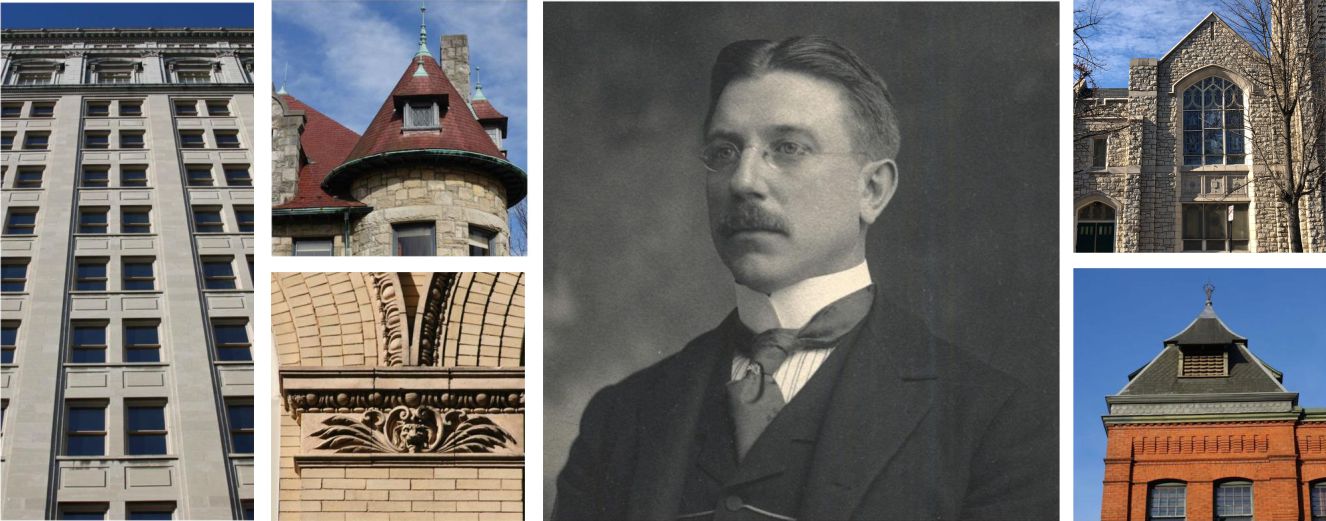
DOWNTOWN LANCASTER WALKING TOUR
May 1, 2019Gregg Scott, FAIA, Partner Emeritus at RLPS Architects, will be hosting a private walking tour of Historic Downtown Lancaster, highlighting the impressive architectural career of Lancaster’s own C. Emlen Urban. This tour will highlight a diverse mix of commercial and residential buildings reflecting a myriad of architectural styles, all within a few blocks of the city square.
HANDOUT FOR TOUR:
The following is a pdf file for tour-goers to reference during the tour: Lancaster Walking Tour: Urban’s Architecture

Take a Closer Look at Henry Shaub: An Architect Who Helped Build Lancaster’s “Look”
April 12, 2019Following our multi-part series on architect C. Emlen Urban, this is the first in a series that will focus on another architect whose talents had a lasting impact on Lancaster County.
 Although his portfolio of local work was varied and his list of clients impressive, Henry Y. Shaub’s real fame as an architect was what he was able to accomplish in the classroom. This Lancaster native was acknowledged throughout the eastern United States as the leading authority on school design. He would sit among the students to understand how the physical environment, including natural light, acoustics and special relationships, could affect their ability to learn.
Although his portfolio of local work was varied and his list of clients impressive, Henry Y. Shaub’s real fame as an architect was what he was able to accomplish in the classroom. This Lancaster native was acknowledged throughout the eastern United States as the leading authority on school design. He would sit among the students to understand how the physical environment, including natural light, acoustics and special relationships, could affect their ability to learn.
A rising star in his own right, this young architect was often overshadowed, but not intimidated, by his 24-year-older contemporary C. Emlen Urban. At 25, Shaub struck out on his own and promptly entered and won a nationwide competition to design the highly sought-after Lancaster YWCA commission in 1915.
Little has been written about this noteworthy architect who followed in the footsteps of Urban. He not only continued to reshape the architectural landscape of our community, but also to shape the minds of our children through designing better environments for learning.
This series will focus on the diversified work of architect Shaub including the Lancaster YWCA (c. 1915); Posey Iron Works (c. 1918); Shaub Shoe Store (c. 1929); Manheim Township’s Brecht Elementary School (c. 1929); J.P. McCaskey High School in School District of Lancaster (c. 1936); and Groff Funeral Home (c. 1950) — just to name a few.
Shaub’s innovation and bold design ideas earned him an honor that only 3% of all architects achieve: being named a Fellow of the American Institute of Architects. The fellowship distinction is reserved for architects who have made outstanding contributions to the profession.
 SHAUB BIOGRAPHY
SHAUB BIOGRAPHY
Born Oct. 13, 1887, Henry Y. Shaub was educated at Bordentown Military Institute and Franklin & Marshall Academy, then received an architectural degree from the Carnegie Institute of Technology in 1909.
In 1912, he married Bertha Barron, an orphan who had been raised at the Northern Home for Friendless Children in Philadelphia. They would continue living with his parents, at 246 E. Orange St., for a decade.
Records indicate Shaub registered for both World War I and World War II, but he would never serve in the military due to being described as “crippled from infantile”.
For the full article and photos, subscribers can access the LNP on-line edition of Take a Closer Look at An Architect Who Helped Build Lancaster’s “Look.”